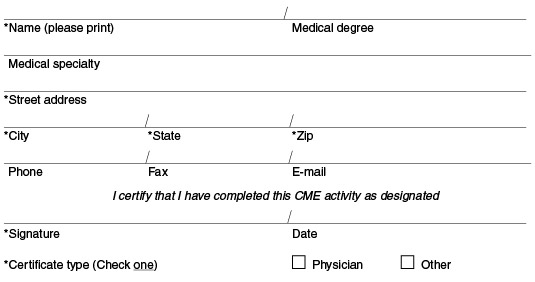
CME Quiz
Please print this page to complete and return the quiz and forms to:
CME Consultants, Inc., 94 Main St. Wakefield, RI 02879,
or fax to (401) 789-1009
1 .The echinocandins demonstrate in vitro antifungal activity against:
|
a) Candida spp.
b) Aspergillus spp. c) Pneumocystis carinii d) all of the above e) none of the above |





|
2. Empiric antifungal therapy is the initiation of antifungal therapy in patients with persistent fever and neutropenia despite the use of broad-spectrum antibiotics only after cultures are positive for a pathogenic yeast or mould.
True or false?
|
a) True
b) False |


|
3. Caspofungin plus L-AmB or caspofungin plus voriconazole have been shown to be useful salvage therapy for invasive aspergillosis refractory to amphotericin B. However:
|
a) Combination therapy is still experimental
b) The small population sizes make these studies difficult to interpret clinically c) Large, well designed studies are needed to determine their value in invasive fungal infection d) Clinical studies are needed to gain further experience of this approach to treatment e) All of the above |





|
4. Lipid formulations of amphotericin B have been developed in an effort to reduce the dose-limiting toxicity of this drug.
True or false?
|
a) True
b) False |


|
5. Risk factors for invasive fungal infections include:
|
a) Immunosuppressive therapy
b) Neutropenia c) Recent major surgery d) All of the above e) None of the above |





|
6. In most surveys Candida albicans is the species isolated in virtually all cases of nosocomial candidemia.
True or False?
|
a) True
b) False |


|
7. Invasive aspergillosis is typically acquired following:
|
a) the use of catheters
b) solid organ transplant c) inhalation of airborne spores d) exposure to broad-spectrum antimicrobial agents |




|
8. A recent CDC survey showed declining mortality due to Candida. This decrease was suggested to be due to better recognition of these infections and earlier initiation of antifungal therapy.
True or false?
|
a) True
b) False |


|






